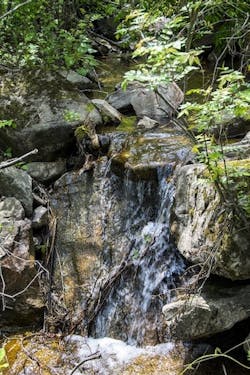Manganese Greensand Filter Removes Iron, Manganese, Arsenic from Groundwater
For more information, you can call Hungerford & Terry, Inc. at 856.881.3200.
undefinedManganese greensand is a specially processed medium for iron, manganese, and hydrogen sulphide removal. This premium non-proprietary filter medium is processed from glauconitic greensand on which a shiny, hard finite thickness manganese oxide coating is formed and is firmly attached on every grain by a controlled process.
In the years prior to World War II, researchers in the water treatment field working with well-known chemical theories of oxidation and reduction sought and developed a basic technology of manufacturing manganese greensand from the mineral glauconite.
Manganese greensand is a specially processed medium for iron, manganese, and hydrogen sulphide removal. This premium non-proprietary filter medium is processed from glauconitic greensand on which a shiny, hard finite thickness manganese oxide coating is formed and is firmly attached on every grain by a controlled process.
Manganese Greensand Filter Process
This process utilizes the ion exchange properties of greensand to form a manganese base material which is converted to manganese oxides by oxidation with potassium permanganate. The material has a high buffering or oxidation-reduction capacity due to the well-defined manganese oxide coating. The manganese greensand can oxidize over 300 grains of manganese per cubic ft or reduce over 1 oz. of potassium permanganate per cubic ft.
The grains of manganese greensand are of both the size and shape to capture the fine precipitates of iron and manganese which pass through the upper coarse anthracite layer during normal service conditions.
A true manganese greensand process requires no detention time, no filter media, no high concentration of chlorine, and no sulphur dioxide.
Manganese greensand is catalytic by nature and is not soluble. There is no increase in the total dissolved solids of the treated water, and it is not necessary to backwash manganese greensand every time the well pump starts up.
The manganese greensand process has been used in the U.S. since the 1950s. During the early years of its use, Hungerford & Terry, Inc. of Clayton, New Jersey, worked to improve the process and eventually developed the Ferrosand CR Process, patented in 1965.
The Ferrosand Filter has been used since then by thousands of municipalities and industrial customers worldwide.
Ferrosand Filter Media is manufactured to exact specifications to ensure the complete oxidation of soluble iron, manganese, and arsenic using stoichiometric quantities of oxidizing agents, without the need for long reaction times or elevated pH levels. (For arsenic removal, a pre-feed of ferric chloride may be required.)
As a filter media it operates on the chemical principal of oxidation and reduction, and the well known catalytic effects of manganese oxides.
A major benefit of Ferrosand, attributed to its chemical properties, is that it can be used in two distinct methods of operation. This allows for flexibility in the design of the water treating equipment, with specific features tailored to the raw water characteristics.
Two Methods of Design, Operation
Ferrosand CR for Iron Removal
The Ferrosand Continuous Regeneration (CR) process is used primarily when iron removal is the objective, with or without the presence of manganese. For more than 25 years in thousands of installations, this technology has proven to be the most cost effective design when iron predominates in the raw water.
The CR method uses a continuous pre-feed of potassium permanganate (KMnO4) or a combination of chlorine (CL2) and KMnO4 to the raw water prior to contacting the Ferrosand Filter. Soluble iron and manganese are oxidized to the insoluble form and filtered out by a dual media anthracite / Ferrosand bed.
Due to the unique chemical and physical properties of the Ferrosand, attributable to the multivalent manganese oxide coating covering the greensand grains, iron and manganese are removed to levels required by the Safe Water Drinking Act or process requirements.
Manganese oxide has a well known catalytic effect on the oxidation of soluble iron and manganese, and also provides a redox buffer capable of either oxidizing remaining traces of iron and manganese, or reducing excess KMnO4 as required.
This not only ensures the consistent removal of iron and manganese, but also maintains the Ferrosand in a regenerated state, without the need for batch KMnO4 regeneration.
Ferrosand IR for Manganese Removal
For groundwaters containing only manganese, or manganese with lesser amounts of iron, the Intermittent Regeneration (IR) process may be in order. It allows for extended run lengths with a minimum amount of head loss during the filter run. In the IR process, a filter bed of Ferrosand is periodically regenerated with a solution of KMnO4. The frequency of regeneration is contingent upon the concentration of raw water manganese and the volume of water treated.
During the service cycle, manganese is removed by utilizing the oxidative capacity of the Ferrosand. Oxidation of the soluble manganese occurs directly on the Ferrosand grains, becoming an integral part of the manganese oxide coating.
To prevent fouling of the Ferrosand by direct oxidation of soluble iron on the grains, varying amounts of accompanying iron should be oxidized using prechlorination prior to contacting the Ferrosand bed. Normally an IR filter will be designed with a bed consisting entirely of Ferrosand.
However, depending on the concentration of iron in the raw water, a dual media anthracite / Ferrosand bed may be specified.
This article was originally published on Mar. 13, 2003. It has been revised for clarity.
